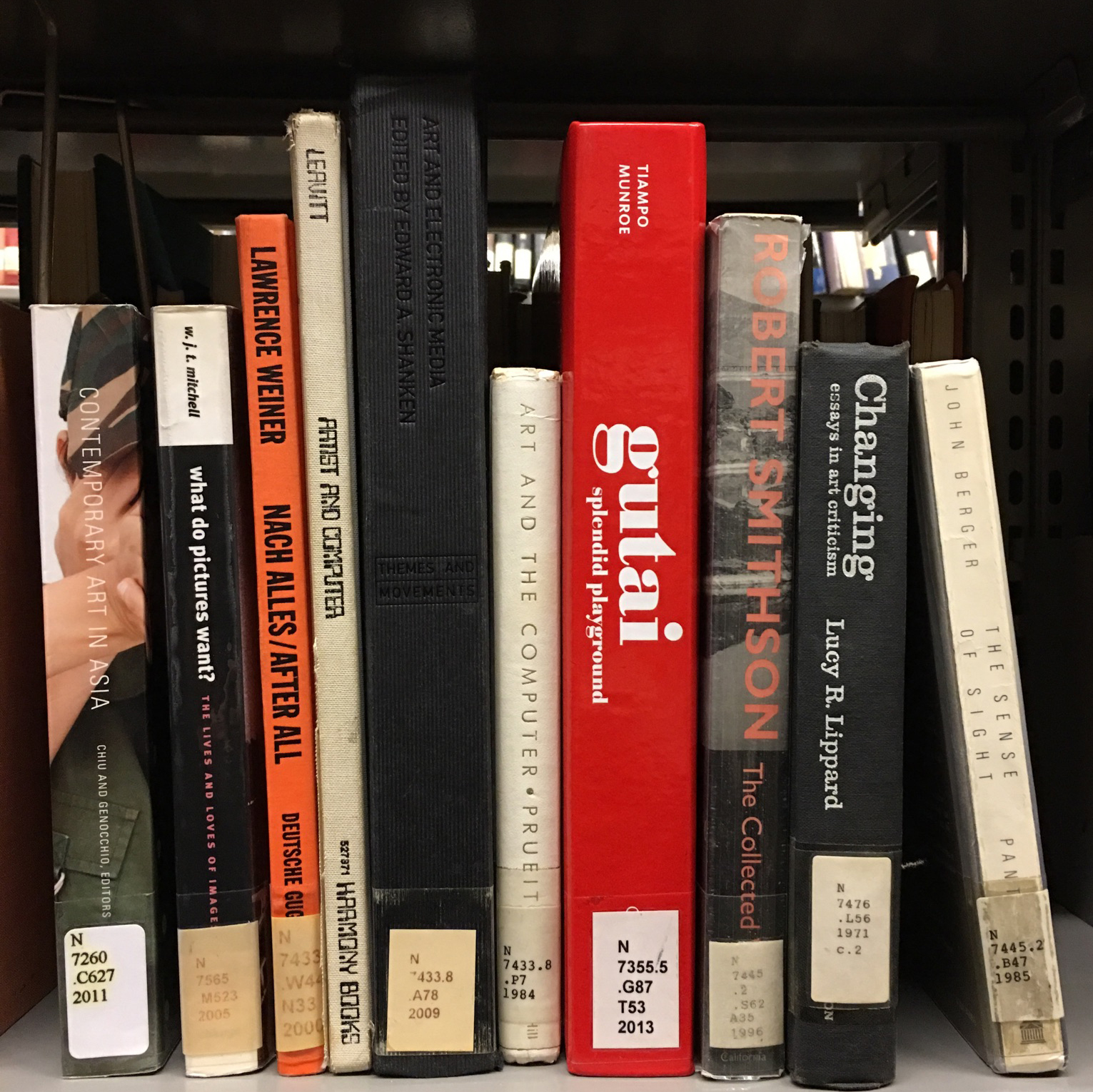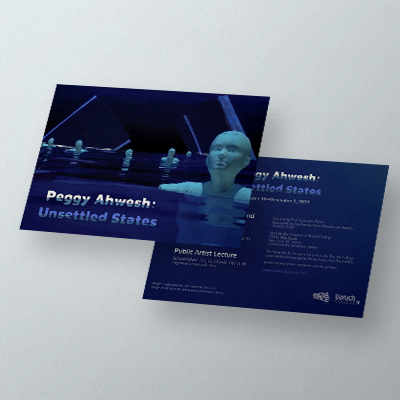Past Exhibition
Peggy Ahwesh: Unsettled States
September 16 – December 1, 2019
The exhibition Peggy Ahwesh: Unsettled States will be on view September 16–December 1, 2019 at the New Media Artspace at Baruch College.
The Wasserman Jewish Studies Center and the New Media Artspace will host a public artist lecture on Tuesday, November 26, 2019 from 6:00 to 8:00 P.M. in Engelman Recital Hall, BPAC. Admission is free to all Baruch students. Tickets coming soon. Entrance to BPAC is on 25th Street between Lexington and 3rd Avenue.
We are also pleased to host casual discussions with the artist for Baruch students on Friday, September 27, 2019 from 1:30 to 3:30 P.M. and on Wednesday, October 2, 2019 from 3:00 to 4:30 P.M. in the New Media Artspace and room 415 in the Library and Information Building.
Curatorial Statement
“In this confused series of intervals, between things that do not exist, I ask myself of what remains, of what possible use it is to me.”
In Peggy Ahwesh’s She Puppet, these words are recited by Lara Croft, the eternally youthful—nevertheless perpetually succumbing—videogame heroine. She Puppet is the earliest of the six video works that comprise Peggy Ahwesh: Unsettled States, a solo exhibition of single-channel videos by the renowned feminist filmmaker that attend variously to borders and their crossings. Spanning nearly two decades and diverse visual styles, these works might themselves be considered a “series of intervals,” or better yet, a series of propositions that borders may be “things that do not exist.” And if so, we must ask ourselves, “of what possible use” are borders and their “remains” to us?
Ahwesh’s work supplies a nuanced perspective on the theme of borders, at a time when hot button headlines about borders and immigration feature prominently in mass media. The treatment of these subjects in mainstream news coverage may leave viewers further entrenched in polarized camps; however, Ahwesh’s videos take the opposite tack. Specifically, by a dopting a dynamic of unsettling, they refuse any form of entrenchment from the outset. This takes shape in manifold ways: ethically, her works trouble borderlines that violently sever families and communities; politically, their ecofeminist stance destabilizes the seemingly smooth operations of settler colonialism; conceptually, they disrupt territorial logics and structures; figuratively, Ahwesh portrays upheavals in wind and waves; and materially, she references the uncanniness of new technologies that document, simulate, and circulate our own unsettled states.
Significantly, Unsettled States addresses the external cartographic boundaries that delineate national territories, as well as the internal coordinate systems that define personal psychic terrains. Some works in this exhibition address the borders of nation states and the political, ecological, and humanitarian crises that disrupt them. Others operate more existentially, unraveling the comforting confidence of belonging that borders seek to stabilize. Throughout, however, Ahwesh profoundly questions “what remains” of the very possibility of belonging, asking, for example, what purchase we really have on the objects we call our “belongings” in a historical moment of pervasive war, climate change, and precarious citizenship that makes us foreign to ourselves. As Croft reflects in the final lines of She Puppet, “However near my heart seemed to beat, it was always far away. We are who we are not and life is swift and sad.”
Throughout her career, Ahwesh has remained resolutely unsettled in her stylistic choices, eschewing a signature authorial style to rove freely across disparate visual languages. The works in Unsettled States reflect this wandering polyglot sensibility, yet taken together they achieve paradoxical unity, displaying a liminal state of being simultaneously inside, outside, and on the move. Harkening to her early punk films and feminist home movies from the 1980s, they seem to probe for origins while attacking patriarchal orders and proprietary enclosures. While Ahwesh’s videos simultaneously lament and celebrate the historical porosity of borders, they also solidify an expansive ethic of welcome, compassion, solidarity, and kinship. Perhaps Ahwesh, too, is who she is not.
Floor 2: Kansas Atlas (2019)
The exhibition begins with Kansas Atlas, a video shot in a small Kansas town that is the exact geographical center of the United States. As the imagery shifts between ground-level and airborne perspectives, the voice of writer Marianne Shaneen describes taking flight in a dreamy litany of associations, mapping her alienation as it spreads, web-like, over the land. Shaneen’s ecofeminist text connects ecological degradation with environmental justice and the subordination of marginalized populations. “There are no straight lines in nature,” her voiceover reminds us. “I’m flying over the gridlines of Eden’s monocrops. Their rectilinear edges are signs of diminishing ecological diversity, species diversity, and cultural diversity.” Kansas Atlas juxtaposes the sprawling agricultural landscape of an American center known for religious fundamentalism against the asymmetrical distribution of diasporic beliefs that disperse like genetically engineered seeds in the wind.
Floor 3: She Puppet (2001)
In She Puppet, Ahwesh narrates Tomb Raider gameplay machinima with text fragments sourced from Fernando Pessoa’s Book of Disquiet, Joanna Russ’s The Female Man, and the Afrofuturist musician Sun-Ra. With their words in her mouth, the Lara Croft character “speaks” of her existential uncertainty. She confesses to being always out of place, even while compelled to run, to swim, to fight; that is, to navigate and master space as she ascends the levels of the game. As we move through our worlds, She Puppet seems to ask, might the same not be so for us all?
Floor 4: The Blackest Sea (2016) and The Falling Sky (2017)
In a pair of videos, The Blackest Sea and The Falling Sky, Ahwesh shows how contingencies and crises can breach even the most carefully instrumentalized orders. Both works feature tightly reedited animations produced by the online news agency TomoNews. In the animations, scenes of intact rational order are also scenes of grotesque consumerism and science as spectacle. With dark humor, Ahwesh cuts them against visions of political, environmental, and humanitarian collapse—from police brutality in Ferguson, to climate change, to the Syrian refugee crisis. The resulting montage reveals how unpredictability persists, even amidst a fully coordinated world of data, logistics, and networked communication: the turbulent nature of seas and skies ruptures territorial logics. Mirroring the global reach of high tech, these realms lie outside the partitions of national territories and overflow the rational orders borders impose onto landmasses.
Floor 5: Border Control (2019) and Re: The Operation (2014–19)
Inverting Kansas Atlas’s perspective from the center of this country, the exhibition concludes with two videos that show political events at the far reaches of the United States, one that took place overseas and one that occurred on U.S. soil. Putting these moments from 2011 and post-2016 into proximity shows how separate incidents, each at the edges of a nation, still touch and inform each other. Entangled, they co-develop a shared historical imaginary in which either one could be possible.
Re: The Operation depicts conflicting reconstructions of the assassination of Osama Bin Laden by the U.S. military. A split-screen format shows news animations unfolding side-by-side, sometimes in sync and sometimes deviating from each other. In these rendered retellings, public fascination with an archrival’s death begins to feel like a movie or game, stoking disbelief, and laying bare how official history, mythmaking, and storytelling converge. Border Control is a stylized video study of a series of test models for the Trump Administration’s proposed wall at the U.S.–Mexico border; by chance, Ahwesh’s camera recorded a man momentarily climbing over the wall before dropping out of view and into the United States. Border Control is shot “objectively” through the lens of a video camera, but its refracted imagery makes a moment of mundane desperation—a border crossing—unseeable, so its subject remains unresolved.
Artist Bio
Peggy Ahwesh is a media artist who got her start in the 1970’s with feminism, punk and amateur Super 8 filmmaking. Her works have recently exhibited at The Kitchen, New York; Foxy Production, New York; Los Angeles Contemporary Exhibitions (LACE), Los Angeles; Maccarone, New York; Salon 94, New York; Murray Guy, New York; Chateau Shatto, Los Angeles, CA; Berwick Film & Media Arts Festival, Berwick-upon-Tweed, UK; Gasworks, London, UK; and Arts Santa Mònica, Barcelona, Spain; among others.
Her films and videos have been shown worldwide including at the Museum of Modern Art (MoMA), New York; Whitney Museum of American Art, New York; New Museum, New York; Film at Lincoln Center, New York; MoMA PS1, Queens, NY; Carnegie Museum of Art, Pittsburgh, PA; The Tate Modern, London, UK; British Film Institute (BFI), London, UK; Guggenheim Museum, Bilboa, Spain; among many other institutions.
Ahwesh has received grants and awards including from the Jerome Foundation, the Guggenheim Foundation, Creative Capital, NYSCA and the Alpert Award in the Arts. She was born in Pittsburgh, PA and currently lives and works between Brooklyn, NY and the Catskills.
Peggy Ahwesh: Unsettled States is curated by Katherine Behar, Associate Professor in the Fine and Performing Arts Department in the Weissman School of Arts and Sciences at Baruch College, CUNY. The exhibition is generously sponsored by the Sandra Kahn Wasserman Jewish Studies Center under the directorship of Professor Jessica Lang. The exhibition is made possible by support from the Baruch Computing and Technology Center (BCTC), the Weissman School of Arts and Sciences, and the Newman Library. Special thanks to Microscope Gallery, Elle Burchill, and Andrea Monti. All images appear courtesy of the artist and Microscope Gallery.
Visit Us
Public Hours
The gallery is open to the public by appointment during regular library hours. Please contact newmediaartspace@gmail.com to arrange a visit.
Location
151 E. 25th StreetNew York, NY 10010
Located in the Newman Library
About Us
The New Media Artspace is a teaching exhibition space in the Department of Fine and Performing Arts at Baruch College, CUNY. Housed in the Newman Library, the New Media Artspace showcases curated experimental media and interdisciplinary artworks by international artists, students, alumni, and faculty.
Follow Us
Feedback
Have thoughts about our exhibitions? Leave a comment here!
















